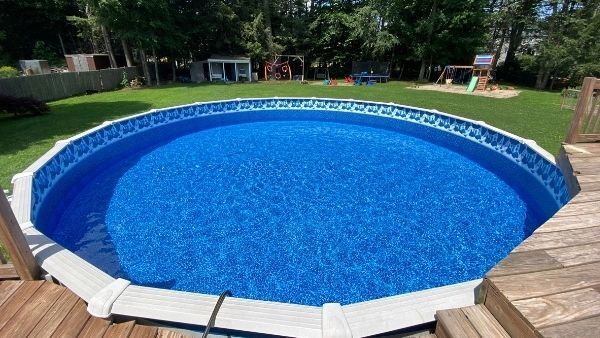Imagine your pool as a delicate ecosystem, where a slight imbalance can lead to murky waters and potential health hazards. To maintain a clean and safe environment, regular testing of your pool water is essential. By monitoring the chemical balance and identifying any issues, you can prevent the need for extensive cleaning and water changes.
In this article, we will provide a comprehensive guide on how to accurately test your pool water for pH, alkalinity, chlorine, cyanuric acid, calcium hardness, copper, and iron levels, ensuring a well-maintained and hazard-free pool.
Key Takeaways
- Regular testing of pool water is essential to monitor the chemical balance and identify any issues.
- Testing should be done at least once a month, as well as after rainstorms, pool parties, and weather changes.
- Different types of water testing kits, such as liquid kits, testing strips, and digital kits, are available for accurate testing.
- It is important to test for pH, alkalinity, chlorine, cyanuric acid, calcium hardness, copper, and iron levels to maintain proper water balance and safety.
The Importance of Pool Water Testing
Regular testing of pool water is essential for ensuring the proper chemical balance and overall safety of the pool. Pool water is constantly exposed to various contaminants such as dirt, debris, bacteria, and organic matter. Without regular testing, it is impossible to know the true state of the pool's invisible chemicals, which can lead to water that is unbalanced and unsafe for swimmers.
Testing your pool water allows you to monitor the chemical balance, including pH levels, alkalinity, chlorine, cyanuric acid, and calcium hardness. By regularly testing these parameters, you can identify and fix any issues in your pool before they become major problems. This can help reduce the need for extensive cleaning and water changes, saving you time and money in the long run.
Properly balanced water not only keeps your pool clean and clear, but it also ensures the safety of swimmers. For example, maintaining the correct levels of chlorine is crucial for disinfection and preventing the growth of harmful bacteria and algae. Additionally, testing for alkalinity and calcium hardness helps prevent issues such as scale formation and corrosion of pool equipment.
It is recommended to test your pool water at least once a month, in addition to opening and closing the pool. However, it is also important to test after rainstorms, pool parties, and weather changes, as these can affect the chemical balance of the water. If you notice any issues such as cloudiness or color changes, it is advisable to conduct a test to identify the source of the problem.
To accurately test your pool water, gather a water sample away from skimmers and return jets. Use a clean container with a lid to store the sample and follow the specific instructions of your testing equipment. There are different types of water testing kits available, including liquid testing kits, testing strips, and digital testing kits. Each kit has its own advantages and disadvantages, so choose the one that best suits your needs and preferences.
When to Test Your Pool Water
Before making any adjustments to your pool water, it is important to test it to determine its current chemical balance. Testing your pool water regularly is crucial to ensure that it is clean, safe, and properly balanced.
But when should you test your pool water?
It is recommended to test your pool water at least once a month in addition to the opening and closing of your pool. However, there are certain circumstances that may require more frequent testing. After rainstorms, pool parties, and weather changes, it is advisable to test your pool water to detect any changes in its chemical balance. Additionally, it is important to test your pool water before algae treatment and when adding water to the pool.
If you notice any issues with your pool, such as cloudiness or changes in color, it is also a good idea to test the water. This will help you identify and address any problems promptly, ensuring that your pool remains clean and inviting.
If you are not comfortable testing your pool water yourself, professional testing is always an option. Professionals have the knowledge and expertise to accurately assess your pool water and recommend any necessary adjustments.
Now that you know when to test your pool water, let's move on to the next section, where we will provide you with a step-by-step guide to accurate testing.
Step-by-Step Guide to Accurate Testing
To ensure accurate testing of your pool water, it is crucial to follow a step-by-step guide. By following these guidelines, you can avoid common testing mistakes and obtain reliable results.
This will help you maintain the chemical balance of your pool and ensure a safe and clean swimming environment.
Importance of Accuracy
Accurate testing is essential for obtaining reliable results when measuring the chemical balance of your pool water. Pool water analysis allows you to determine the levels of various chemicals such as pH, alkalinity, chlorine, cyanuric acid, and calcium hardness. Knowing these levels is crucial for maintaining a clean and safe pool environment.
By testing your pool water accurately, you can identify any imbalances or issues and take appropriate actions to rectify them. This not only prevents the growth of bacteria and algae but also reduces the need for extensive cleaning and water changes.
Whether you use liquid testing kits, testing strips, or digital testing kits, following the step-by-step process and ensuring accuracy in your testing methods will help you achieve optimal pool water balance and ensure the well-being of those who use your pool.
Common Testing Mistakes
One of the most common testing mistakes is failing to thoroughly clean and dry the testing equipment before each use, as well as between different chemical tests. This can lead to inaccurate results and compromise the effectiveness of the testing process. To ensure accurate testing, it is important to properly maintain and prepare the testing equipment. Below are some common testing mistakes to avoid:
| Common Testing Mistakes |
|---|
| Failing to clean and dry the testing equipment before each use |
| Not following the specific instructions of the testing equipment |
| Using expired or outdated testing reagents |
| Testing pool water immediately after adding chemicals |
| Testing pool water during or immediately after heavy rain or water additions |
Different Types of Pool Water Testing Kits
Advantages and disadvantages of using different types of pool water testing kits:
- Liquid testing kits:
- Known for their accuracy in measuring various chemical levels in pool water.
- Require the addition of specific drops and color comparison to determine the chemical balance.
- Can be prone to user error, as accurately matching colors can be subjective.
- May take longer to provide results compared to other types of testing kits.
- Testing strips:
- Offer convenience and provide multiple tests in one strip.
- Simply dip the strip into the water, wait for the recommended time, and then match the colors on the strip to the provided chart.
- Easy to use and provide quick results.
- May not be as accurate as liquid testing kits.
- The colors on the strips can fade over time, affecting their reliability.
- Digital testing kits:
- Offer precise results and minimize user error.
- Use sensors to measure the chemical levels in the pool water and provide digital readings.
- Easy to use and typically provide accurate results within seconds.
- Can be more expensive compared to other types of testing kits.
- May require regular calibration to maintain accuracy.
Testing for Ph, Alkalinity, Chlorine, Cyanuric Acid, and Calcium Hardness
To effectively maintain the chemical balance of your pool water, it is essential to test for pH, alkalinity, chlorine, cyanuric acid, and calcium hardness. These parameters play a crucial role in ensuring that your pool water is safe and clean for swimming. Testing for these elements can be done using various methods, such as test strips, liquid testing kits, or digital testing kits.
Here is a table summarizing the testing methods for each parameter:
| Parameter | Testing Method |
|---|---|
| pH | Test strips or liquid test kits |
| Alkalinity | Test strips or liquid test kits |
| Chlorine | Test strips, liquid test kits, or digital testing kits |
| Cyanuric Acid | Test strips, liquid test kits, or digital testing kits |
| Calcium Hardness | Test strips, liquid test kits, or digital testing kits |
Testing the pH levels is crucial as it determines the acidity or alkalinity of the water. Maintaining a pH level between 7.2 and 7.4 is optimal for water balance. Alkalinity testing measures the ability of the water to resist changes in pH and should be tested before adjusting pH levels.
Chlorine testing is essential for disinfection and should be done weekly. It helps prevent the growth of bacteria and algae. Cyanuric acid testing is important as it protects chlorine from being degraded by UV rays. Maintaining the correct range of cyanuric acid is necessary to ensure proper chlorine effectiveness.
Calcium hardness testing measures the level of dissolved calcium in the water. High calcium hardness can cause deposits in the pool and plumbing. Monitoring and adjusting calcium hardness levels if necessary is crucial for maintaining a balanced pool.
Testing for Chlorine and Ph Levels
Testing for chlorine and pH levels is crucial in maintaining a balanced and sanitized pool. Chlorine is essential for disinfection and preventing the growth of bacteria and algae. pH levels need to be maintained between 7.2 and 7.4 for optimal water balance.
Utilizing test strips or liquid test kits, pool owners can accurately measure and adjust chlorine and pH levels. This helps ensure a safe and enjoyable swimming experience.
Importance of Balance
Maintaining proper balance of chlorine and pH levels in your pool water is essential for ensuring safe and sanitary swimming conditions. Here are three reasons why balance is important:
- Prevents Bacterial Growth: Chlorine acts as a disinfectant, killing bacteria and preventing the growth of algae in the pool. By regularly testing and maintaining the proper chlorine levels, you can ensure the water remains clean and safe for swimming.
- Protects Swimmers: Imbalanced pH levels can cause skin and eye irritation, making swimming uncomfortable and potentially harmful. By testing and adjusting the pH levels, you can create a comfortable environment for swimmers and reduce the risk of skin and eye problems.
- Prolongs Pool Life: Imbalanced chlorine and pH levels can lead to corrosion of pool equipment, such as pipes, filters, and pumps. By maintaining the proper balance, you can extend the lifespan of your pool and avoid costly repairs or replacements.
Sanitization and Ph Balance
Achieving proper sanitization and maintaining the correct pH balance in your pool water is essential for ensuring a safe and healthy swimming environment. Sanitization is important for preventing the growth of bacteria and algae, while pH balance affects water clarity and the effectiveness of sanitizers. Testing for chlorine and pH levels is crucial in pool water chemistry. Chlorine should be maintained at the recommended levels to effectively sanitize the pool. pH levels should be between 7.2 and 7.4 for optimal water balance. Testing can be done using test strips or liquid test kits, which provide accurate results. If adjustments are necessary, a pool chlorine calculator and pH calculator can be used to determine the correct amounts of chemicals to add.
| Testing for Chlorine | Testing for pH |
|---|---|
| Use test strips or liquid test kits | Use test strips or liquid test kits |
| Check chlorine levels regularly | Check pH levels regularly |
| Maintain recommended levels for effective sanitization | Maintain pH between 7.2 and 7.4 |
| Use pool chlorine calculator for adjustments | Use pH calculator for adjustments |
Testing for Total Alkalinity
Total alkalinity is a crucial parameter to determine the water's ability to resist changes in pH. It is important to test for total alkalinity in your pool water to ensure that it is properly balanced.
Here is a guide on how to test for total alkalinity:
- Use a liquid testing kit: A liquid testing kit is the most accurate option for testing total alkalinity in your pool water. These kits typically include test liquids such as Sodium Thiosulfate and sulphuric acid.
- Follow the instructions: Each liquid testing kit will have specific instructions on the number of drops and water volume to use for the test. It is important to follow these instructions carefully to get accurate results.
- Multiply the number of sulphuric acid drops: After performing the test, you will need to determine the total alkalinity level. Multiply the number of sulphuric acid drops by 10 to get the total alkalinity in parts per million (ppm).
Once you have determined the total alkalinity level, you can take action to raise or lower it if needed. High total alkalinity can lead to cloudy water and difficulty in maintaining the proper pH levels. On the other hand, low total alkalinity can result in pH fluctuations and corrosion of pool equipment.
Regularly testing for total alkalinity, along with other parameters such as pH, chlorine, cyanuric acid, and calcium hardness, is essential for maintaining a healthy and balanced pool. By following a comprehensive pool water testing guide, you can ensure that your pool water is clean, safe, and enjoyable for swimming.
Testing for Calcium Hardness and Cyanuric Acid
How do you test for calcium hardness and cyanuric acid in your pool water?
Testing for calcium hardness and cyanuric acid is an essential part of pool water testing. These tests help ensure that your pool water is properly balanced and safe for swimming.
To test for calcium hardness, there are two common methods: using test strips or liquid test kits. Test strips are convenient and easy to use. Simply dip the strip into the pool water and wait for the recommended amount of time. Then, compare the color of the strip to the color chart provided. The color will indicate the level of calcium hardness in your pool water. If the calcium hardness level is too high, it can lead to the formation of scale and cloudy water. In contrast, if the calcium hardness level is too low, it can cause corrosion of pool equipment.
Liquid test kits are another option for testing calcium hardness. These kits typically come with reagents that need to be mixed with a water sample from your pool. Follow the instructions provided with the kit to accurately measure the calcium hardness level. Liquid test kits often provide more precise results compared to test strips.
Cyanuric acid testing is also important in pool water testing. Cyanuric acid helps protect chlorine from degradation by UV rays, but excessive levels can reduce chlorine's effectiveness. To test for cyanuric acid, you can use either test strips or liquid test kits. Follow the instructions provided with the kit to obtain accurate results. If the cyanuric acid level is too high, it may be necessary to dilute the pool water or partially drain and refill the pool.
Regular testing for calcium hardness and cyanuric acid is crucial to maintaining a balanced and safe pool environment. By monitoring these levels and taking appropriate action when necessary, you can ensure that your pool water is clean, clear, and enjoyable for swimming.
Frequently Asked Questions
Can I Use Regular Tap Water for Testing My Pool Water?
Yes, you can use regular tap water for testing your pool water. However, it is important to note that tap water may contain certain minerals or chemicals that can affect the accuracy of your test results.
To ensure the most accurate readings, it is recommended to use distilled water for testing. Distilled water is free from impurities and provides a reliable baseline for testing the chemical balance of your pool water.
How Long Should I Wait After Adding Chemicals to Test My Pool Water?
It is recommended to wait for a specific amount of time after adding chemicals to your pool water before testing it.
The waiting period varies depending on the type of chemical added.
For chlorine, it is advisable to wait at least 4 hours before testing.
For pH adjusters, such as acid or soda ash, it is recommended to wait 1-2 hours.
This waiting period allows the chemicals to fully dissolve and distribute in the water, ensuring accurate test results.
Always refer to the manufacturer's instructions for precise waiting times.
Is It Necessary to Test for Copper and Iron in My Pool Water?
Yes, it is necessary to test for copper and iron in your pool water. Copper and iron can enter the pool water and cause issues such as staining and discoloration.
Low pH levels can lead to increased levels of metals in the pool.
Can I Use Different Brands of Testing Kits Together for Accurate Results?
Yes, it is possible to use different brands of testing kits together for accurate results.
However, it is important to ensure that the testing methods and measurements are consistent across the different kits. Variations in instructions or reagents may lead to discrepancies in results.
To ensure accuracy, it is advisable to carefully read and follow the instructions provided by each testing kit, and consider utilizing a single brand or type of testing kit for consistent and reliable results.
How Do I Dispose of the Water Sample After Testing?
After testing your pool water, it is important to properly dispose of the water sample. The water sample should be poured out in an area away from plants or vegetation, as some chemicals in the water may be harmful.
Avoid pouring the water onto paved surfaces or into storm drains, as it can potentially contaminate the environment.
It is recommended to dispose of the water sample in a responsible manner that adheres to local regulations and guidelines for wastewater disposal.




